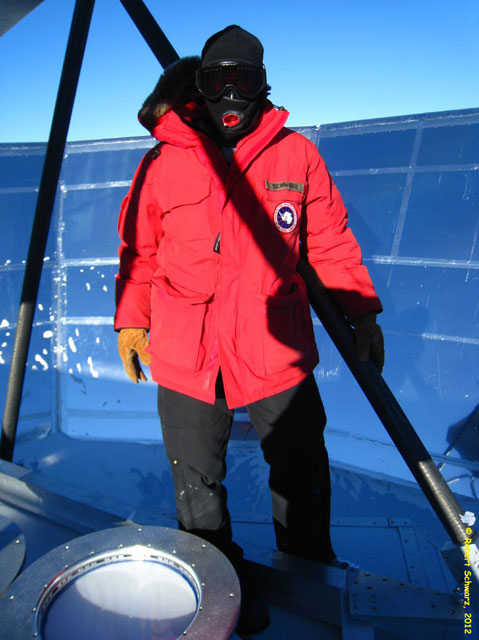|
The Ice ManSchwarz settles in for his eighth winter at the South PolePosted April 13, 2012
Who needs outer space when you have the South Pole? Not Robert Schwarz. His aspirations to be an astronaut never quite worked out. But he’s spent more time at the bottom of the Earth — possibly triple the number of days — than any human has orbiting the planet. “It’s space for the poor — or little — man,” says Schwarz, a native of Munich, Germany, who is spending his eighth winter at the South Pole Station The 42-year-old physicist recalls first becoming interested in astronomy around the mid-1980s, while on a Boy Scout field trip to the island and active volcano Stromboli not far off the coast of Sicily. The lightly inhabited island was pitch-black during the evening hours. “It was an absolutely amazing star sky,” Schwarz says. “That’s how I got hooked on that. I wanted to know more about it.” That thirst for knowledge about the universe led to an undergraduate degree in chemistry, math and physics, and eventually a master’s degree in physics from the Ludwig-Maximilians-University in Munich. But well before completing his graduate work, Schwarz got his first shot at a trip to the South Pole to work for the University of Wisconsin-Madison 
Photo Credit: Robert Schwarz
Robert Schwarz bundled up while working on the top of the SPUD telescope.
That was the summer-winter of 1996-97. The gleaming and modern South Pole Station that sits on stilts above the polar plateau didn’t exist then. Schwarz lived in the old dome station. In the corner of his room, where two outside walls met, a block of ice formed during the winter months. Yet it was cozy, and that first trip would begin a series of long-term assignments at the South Pole in support of projects with hip acronyms like GASP, RICE and QUaD. Only two people in the world have spent more winters at the South Pole than Schwarz, and they’re both wintering again this year. Johan Booth, a technician at NOAA’s Atmospheric Research Observatory Schwarz insists there is no competition between the trio for the honor of most winters. “I wouldn’t come down for a winter just for that. That would be insane,” he says. “I’m not going to do it for the rest of my life, but I decide from year to year if I’m going to do another one.” Still, he briefly held the record in 2007 at six winters, but then took several years off to travel and live in the Alps. Schwarz does note that the trend of multiple winters seems to be a recent phenomenon of the last 10 to 15 years. Two people — Dana Hrubes and Barry Horbal — each have six winters under their belts, while another five people have spent five winters at the South Pole, including Joseph Gibbons, aka Jake Speed, who still holds the all-time record for most consecutive winters, from 2000-2004. In fact, 40 percent of the 50 people wintering this year have previously spent the cold, dark months at 90 degrees south, according to winter-over statistics “There are a lot of great people down here again this year,” says Schwarz, who also enjoys the crisp night sky and the colorful aurora shows that splash across the background of the Milky Way more often than not during the winter. “It’s absolutely amazing and breathtaking,” he says of the auroras, natural light shows caused by the interaction of charged particles high in the Earth’s atmosphere. The various challenges of the job also keep him coming back. Most of the time — fingers crossed — problems usually involve a computer glitch. But sometimes a major malfunction will require a marathon work session until the problem is fixed. The goal is to make sure there are as few gaps as possible in the data stream from an experiment. “Part of my job is like being a doctor here. I’m here if something goes wrong,” Schwarz explains. “Things can go dramatically wrong and all hell can break loose, and then we try to figure out what went wrong.” The sun only recently disappeared from the horizon, meaning the stunning night sky and showy auroras aren’t too far away now. Schwarz has settled into this year’s winter routine — making the daily, nearly mile-long trek to the station’s Dark Sector where the telescopes are located. There are volleyball games and movie nights that keep the social calendar busy. Then there are the photography projects, like a time-lapse video capturing the final spins of the sun around the darkening horizon. And possibly the best part: Planning the next travel adventure, knowing the South Pole will always be there, beckoning like the mysteries in the night sky.
“I can take a year off again and travel the world,” Schwarz says. “It’s kind of nice to be able to come down here and work for a year or a few years and take off again.” Follow Schwarz's adventures at the South Pole on his blog.
|



For USAP Participants |
For The Public |
For Researchers and EducatorsContact UsU.S. National Science FoundationOffice of Polar Programs Geosciences Directorate 2415 Eisenhower Avenue, Suite W7100 Alexandria, VA 22314 Sign up for the NSF Office of Polar Programs newsletter and events. Feedback Form |


